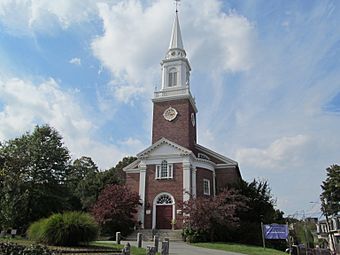Sumner Hill Historic District facts for kids
Quick facts for kids |
|
|
Sumner Hill Historic District
|
|

Hope Central Church
|
|
| Location | Jamaica Plain, Boston, Massachusetts |
|---|---|
| Area | 365 acres (148 ha) |
| Architect | Andrews, Jacques & Rantoul; et al. |
| Architectural style | Second Empire, Italianate, Queen Anne |
| NRHP reference No. | 87001889 |
| Added to NRHP | October 22, 1987 |
The Sumner Hill Historic District is a special neighborhood in Jamaica Plain, a part of Boston, Massachusetts. It's known for its beautiful homes built in the late 1800s. These homes show off different styles like Second Empire, Italianate, and Queen Anne. This area was added to the National Register of Historic Places in 1987. This means it's an important place that helps us understand history.
Contents
What Makes Sumner Hill Special?
A Look at the Neighborhood's Design
The Sumner Hill Historic District covers about 365 acres (148 hectares). It's located near Centre Street, Seavern Avenue, Everett Street, and Carolina Street. The streets in this area are not straight. They curve and wind around because they follow the natural hills. This makes the neighborhood feel unique and interesting.
Most of the buildings here are single-family homes. They are usually two or three stories tall and made of wood. You can also find some brick rowhouses on the streets around the edges.
Buildings That Stand Out
While most buildings are homes, there are a few other important structures. You'll find three churches grouped together near Elm Street and Seaverns Avenue. There's also the old Jamaica Plain High School building nearby on Elm Street. This school building has now been changed into homes.
How Sumner Hill Grew Over Time
From Farms to Fancy Estates
Long ago, in the 1600s and 1700s, the Jamaica Plain area was mostly farmland. It was part of Roxbury, not Boston, and it helped feed the people in Boston. Later, in the 1700s, rich people from Boston started building large summer homes here. Famous people like John Hancock and Francis Bernard had estates in this area.
One of the oldest houses still standing from this time is the Loring–Greenough House. It was built around 1760. The land around this house used to include the Sumner Hill area.
The Rise of a "Streetcar Suburb"
In the mid-1800s, things changed a lot. New, fast train lines made it easy to travel into Boston. This led to the area becoming a "streetcar suburb." This means people could live outside the city and still get to work easily. The large estates were divided into smaller lots for new homes.
Building in Sumner Hill started in the 1850s. At first, large, grand houses were built on big, beautiful lots for wealthy families. Later, in the late 1800s, more homes were built closer together. These were still high-quality houses, but they were for middle-class families. This mix of homes from different times shows how the neighborhood grew and changed.



